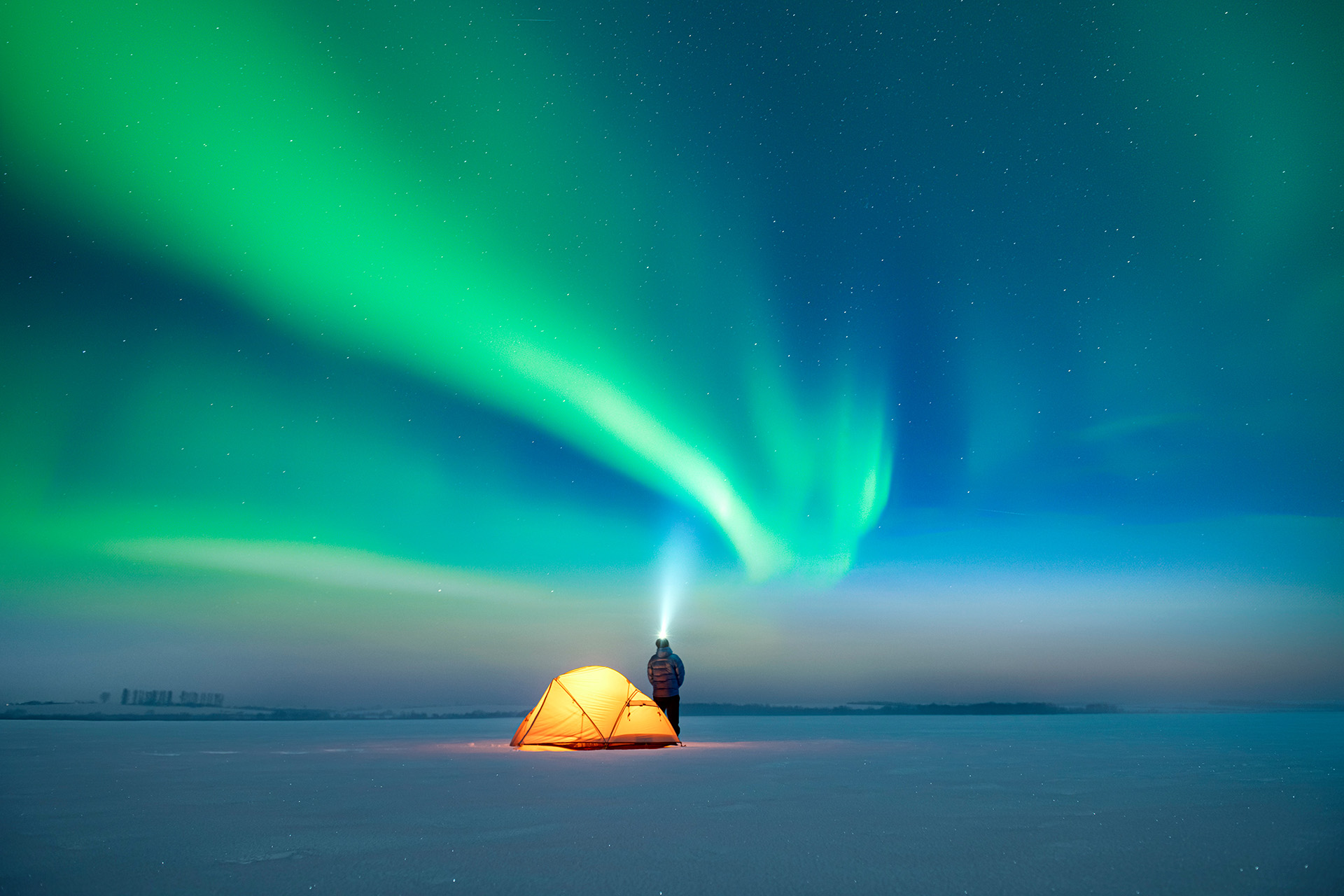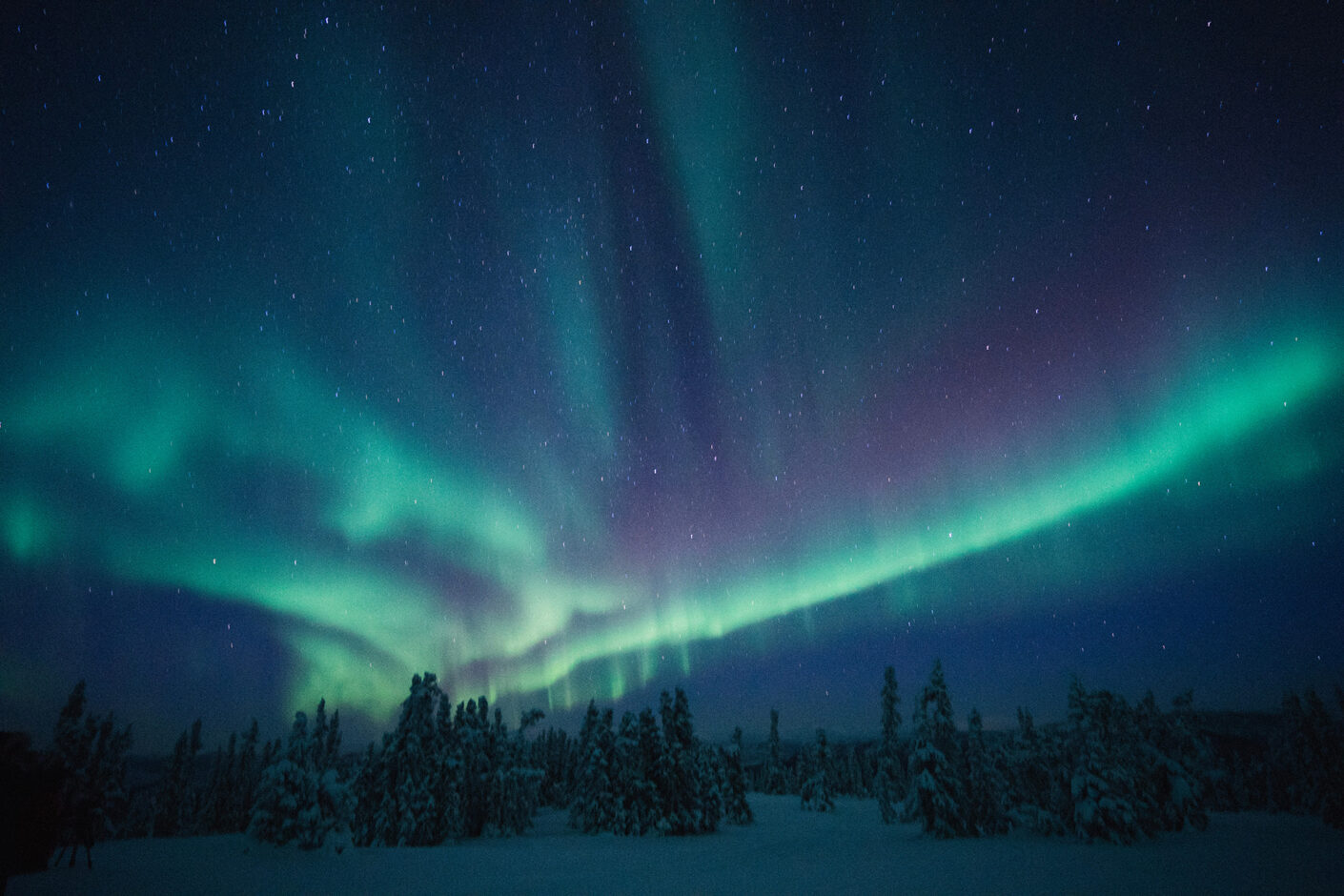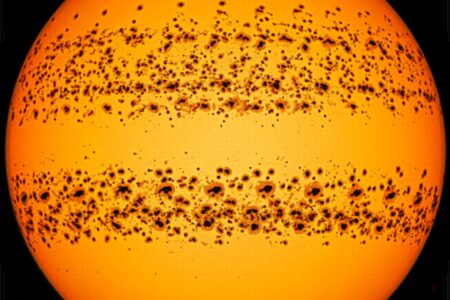The dancing colours of the northern lights are mesmerising. And these beautiful displays are different every night, varying in intensity, pattern and colour palette.
So what causes the aurora colours? And why are they constantly changing?
Here, we look at the science behind this breathtaking spectacle, exploring the colours of the aurora and the atmospheric gases that cause them.

What colour are the northern lights?
Most northern lights are green. But you sometimes see a rare flash of pink. And strong displays can include shades of red, blue, purple, yellow and even white. The colours of the aurora borealis vary from night to night, according to the strength of solar activity.
What causes the aurora colours?
The colours of the aurora borealis are caused when solar particles and gases in Earth’s atmosphere collide.
Solar activity
The northern lights are caused by solar activity. Storms on the surface of the sun release charged particles, which flow from the sun into space in a constant stream called the solar wind.
Some of these charged particles are drawn into Earth’s magnetic field. Here, they’re directed to the poles where they collide with atoms in Earth’s atmosphere. The most common atoms found in Earth’s atmosphere are oxygen and nitrogen.
During periods of high solar activity, more solar particles crash into the atmosphere. This increases the likelihood of vibrant displays and a varied range of aurora borealis colours.
Earth’s atmosphere
When solar particles collide with the atoms in Earth’s atmosphere, the excess energy produced by this collision is released as colourful light.
The colours we see depend on which gas has been involved in the collision — and where that gas is located in the atmosphere. It also depends on which combination of gases are present.
Oxygen gives off a fluorescent green and yellow colour. It also produces shades of red at higher altitudes. Nitrogen causes blue, purple and pink colours.

View the breathtaking colours of the aurora borealis
On an Aurora Nights tour, you travel with an expert aurora guide to the best northern lights locations. So you have an excellent chance of seeing a beautiful aurora display.
Aurora colours and meanings
Now, let’s explore all the possible aurora colours and their meanings.

Green aurora borealis
At altitudes of 100 to 150 kilometres, there are high concentrations of oxygen in Earth’s atmosphere. When solar particles collide with oxygen at these altitudes, we get green northern lights.
Because most solar particles crash into the atmosphere at this altitude — and because the human eye is particularly sensitive to shades of green — we’re more likely to see a green aurora than any other.
Nitrogen can also release a turquoise shade of green. But this is often obscured by the brighter green of an oxygen reaction.
Pink aurora borealis
Pink northern lights are relatively rare and only seen on nights with high levels of solar activity. If the northern lights feature shades of pink, it’s usually at the lower edge of the aurora. This colour is produced by nitrogen molecules at an altitude of around 100 kilometres.
Blue northern lights
A blue aurora borealis tends to appear when solar activity is particularly high. Like shades of pink, blue auroras are created when solar particles collide with the nitrogen atoms in the atmosphere at altitudes of 100 kilometres or less. This is why you tend to see blue northern lights in the lower parts of a display.
Purple northern lights
Purple northern lights are rare. They’re often seen alongside a blue aurora. We’re more likely to see a purple aurora borealis if solar particles react with nitrogen at lower altitudes.
Red aurora borealis
Red auroras are associated with intense solar activity. These shades appear when solar particles react with oxygen at high altitudes of 200 to 250 kilometres, where the atmosphere is less dense. You tend to see red northern lights at the higher edges of a display.
Yellow aurora borealis
Very occasionally, we get to see a yellow aurora. This is caused by a combination of oxygen and nitrogen molecules. This colour mixing sometimes produces shades of orange, too.
White aurora borealis
When the northern lights are faint, they can appear as a milky-white shimmer in the sky. They can also appear as a grey or silver colour. Sometimes, when you point your camera at white northern lights, it will capture colours that you can’t see with the naked eye.
When and where can you see the most colourful aurora displays?
If you’re planning to visit the northern lights, picking the right time and location improves your chances of catching an impressive aurora borealis display. Here’s what you need to know.

When to see the northern lights
You see the most colourful aurora displays when there’s a lot of solar activity.
Solar activity increases when there are more sunspots on the sun. The number of sunspots rises and falls over a period of 11 years. This is known as the solar cycle.
At the sunspot peak (the solar maximum), solar activity is particularly strong. So we tend to get bright, colourful displays during this time.
There are also peaks in solar activity during the spring and autumn equinoxes in March and September every year. And otherwise, the best time to see the northern lights is between September and March.
During autumn and winter, nights in the northern hemisphere grow long and dark — so there are more hours when you can see the aurora.
Where to see the northern lights
The best places to see the northern lights lie within or close to the Arctic Circle. While you occasionally see the northern lights further south, you get more colourful and more impressive displays closer to the North Pole.
In Europe, this means travelling to northern lights destinations, like Iceland and the northern regions of Sweden, Norway and Finland.
Inspired to see the colours of the northern lights for yourself? View our northern lights tours to Iceland, Norway, Sweden and Finland.
Aurora colours: FAQS

What colours are in the aurora borealis?
Green is the most common colour to see in the aurora borealis. But you can also sometimes see shades of red, pink, blue, purple, yellow and white.
Are the southern lights the same colour as the northern lights?
Yes. The southern lights are caused by the same solar activity as the northern lights. So in areas close to the South Pole, you’ll find exactly the same colours and patterns.
What is the rarest aurora colour?
Blue, purple and pink are some of the rarest aurora colours. You only tend to see these colours in the northern lights when there’s a particularly strong display.
What causes the different patterns of the aurora?
The aurora borealis often appears as a curtain of lights. But it can also present as arcs or spirals, often following lines of force in the Earth’s magnetic field.
Can you see aurora colours with the naked eye?
All northern lights colours are visible to the naked eye if the aurora display is intense enough. Green and red are the easiest colours to see. But you may pick up more colours with the help of your camera.
That’s because human eyesight isn’t great in low-light conditions. When it’s dark, we tend to see in shades of white, grey and black.
A camera’s colour sensors work better than our eyes in the dark. This, along with the option to create long exposure shots, means the camera can sometimes see and capture a greater range of aurora colours than the naked eye.





